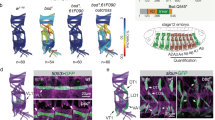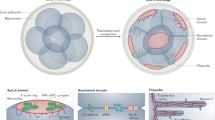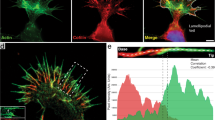Abstract
MOUSE embryos lacking Csk, a negative regulator of Src family kinases, exhibit defects in neurulation and die at mid-gestation1,2. To determine the role of activated Src family kinases in the csk- phenotype, we have introduced mutations in the src and fyn genes3,4 into the csk- mutant background. Genetic analysis reveals that src, but not fyn, is partly epistatic to the csk gene. Biochemical analysis indicates that several cytoskeletal proteins are hyperphosphorylated on tyrosine residues in csk- cells. Regulation of cortactin and tensin hyperphosphorylation is Src-dependent, whereas focal adhesion kinase and paxillin hyperphosphorylation is partly dependent on both Src and Fyn. Furthermore, the src- mutation can restore the normal distribution of cortactin and partly correct filamentous actin organization in csk- cells. Thus, Src family kinases have both specific and overlapping functions in regulation of the cytoskeleton. The disturbance of these functions may be a molecular basis for the phenotype exhibited by csk- mutants.
This is a preview of subscription content, access via your institution
Access options
Subscribe to this journal
Receive 51 print issues and online access
$199.00 per year
only $3.90 per issue
Buy this article
- Purchase on Springer Link
- Instant access to full article PDF
Prices may be subject to local taxes which are calculated during checkout
Similar content being viewed by others
References
Imamoto, A. & Soriano, P. Cell 73, 1117–1124 (1993).
Nada, S. et al. Cell 73, 1125–1135 (1993).
Soriano, P., Montgomery, C., Geske, R. & Bradley, A. Cell 64, 693–702 (1991).
Stein, P. L., Lee, H.-M., Rich, S. & Soriano, P. Cell 70, 741–750 (1992).
Cooper, J. A. in Peptides and Protein Phosphorylation (eds Kemp, B. & Alewood, P. F.) 85–113 (CRC, Boca Raton, 1989).
Imamoto, A., Soriano, P. & Stein, P. L. Curr Opin. genet. Dev. 4, 40–46 (1994).
Lowell, C. A., Soriano, P. & Varmus, H. E. Genes Dev. 8, 387–398 (1994).
Stein, P. L., Vogel, H. & Soriano, P. Genes Dev. 8, 1999–2007 (1994).
Nada, S., Okada, M., MacAuley, A., Cooper, J. A. & Nakagawa, H. Nature 351, 69–72 (1991).
Partanen, J. et al. Oncogene 6, 2013–2018 (1991).
Bräuninger, A., Holtrich, U., Strebhardt, K. & Rübsamen-Waigmann, H. Gene 110, 205–211 (1992).
Hanafusa, H. in Comprehensive Virology Vol. 10 (eds Fraenkel-Conrat, H. & Wagner, R. R.) 401–483 (Plenum, New York, 1977).
Schaller, M. D., Bouton, A. H., Flynn, D. C. & Parsons, J. T. Prog. Nucleic. Acid Res. molec. Biol. 44, 205–227 (1993).
Turner, C. E. & Miller, J. T. J. Cell Sci. 107, 1583–1591 (1994).
Cobb, B. S., Schaller, M. D., Leu, T. H. & Parsons, J. T. Molec. cell. Biol. 14, 147–155 (1994).
Lo, S. H., Janmey, P. A., Hartwig, J. H. & Chen, L. B. J. Cell Biol. 125, 1067–1075 (1994).
Reynolds, A. B. et al. Molec. cell. Biol. 14, 8333–8342 (1994).
Behrens, J. et al. J. Cell. Biol. 120, 757–766 (1993).
Hamaguchi, M. et al. EMBO J. 12, 307–314 (1993).
Wu, H. & Parsons, J. T. J. Cell Biol. 120, 1417–1426 (1993).
Flynn, D. C., Leu, T. H., Reynolds, A. B. & Parsons, J. T. Molec. cell. Biol. 13, 7892–7900 (1993).
Nada, S., Okada, M., Aizawa, S. & Nakagawa, H. Oncogene 9, 3571–3578 (1994).
Rohrschneider, L. R. Proc. natn. Acad. Sci. U.S.A. 77, 3514–3518 (1980).
Wu, H., Reynolds, A. B., Kanner, S. B., Vines, R. R. & Parsons, J. T. Molec. cell. Biol. 11, 5113–5124 (1991).
Lowe, C. et al. Proc. natn. Acad. Sci. U.S.A. 90, 4485–4489 (1993).
Yagi, T. et al. Oncogene 9, 2433–2440 (1994).
Hynes, R. O. & Lander, A. D. Cell 68, 303–322 (1992).
George, E. L., Georges-Labouesse, E. N., Patel-King, R. S., Rayburn, H. & Hynes, R. O. Development 119, 1079–1091 (1993).
Yang, J. T., Rayburn, H. & Hynes, R. O. Development 119, 1093–1105 (1993).
Howell, B. W. & Cooper, J. A. Molec. cell. Biol. 14, 5402–5411 (1994).
Author information
Authors and Affiliations
Rights and permissions
About this article
Cite this article
Thomas, S., Soriano, P. & Imamoto, A. Specific and redundant roles of Src and Fyn in organizing the cytoskeleton. Nature 376, 267–271 (1995). https://doi.org/10.1038/376267a0
Received:
Accepted:
Issue Date:
DOI: https://doi.org/10.1038/376267a0
This article is cited by
-
Glycosphingolipid GM3 prevents albuminuria and podocytopathy induced by anti-nephrin antibody
Scientific Reports (2022)
-
Overexpression of FES might inhibit cell proliferation, migration, and invasion of osteosarcoma cells
Cancer Cell International (2020)
-
Roles of paxillin phosphorylation in IL-3 withdrawal-induced Ba/F3 cell apoptosis
Genes & Genomics (2019)
-
Sensitive and rapid quantification of exosomes by fusing luciferase to exosome marker proteins
Scientific Reports (2018)
-
Unique behavior of Trypanosoma cruzi mevalonate kinase: A conserved glycosomal enzyme involved in host cell invasion and signaling
Scientific Reports (2016)
Comments
By submitting a comment you agree to abide by our Terms and Community Guidelines. If you find something abusive or that does not comply with our terms or guidelines please flag it as inappropriate.



